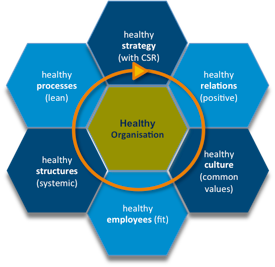Leadership in the Healthy Organisation (1/7)
After we have successively unfolded the concept of the Healthy Organisation in 2014, we would like to start a series on leadership in the HO. This article wants to briefly clarify fundamental thoughts and give an overview of the articles that will follow within this series. Conceptually the HO consists of the following cells: strategy, relationships, culture, employees, structure, and processes.

Since leadership - illustrated as a circle in the figure above - shall serve as a binding unit between the different cells, the question of how leadership within the cells can be shaped in order to achieve a positive effect arises almost automatically. With reference to the individual cells, “positive“ means: behaviour patterns,
- … that pursue the implementation of the company strategy,
- … that have a positive effect on the relationships of the interaction partners (customers, employees, colleagues, suppliers etc.),
- … that enable a value-oriented culture,
- … that focus on the wellbeing of the employees,
- … that set up appropriate organisational structures and
- … that adapt processes in a precisely targeted manner, enabling efficient work.
As target of effective leadership in our understanding extraordinary performance shall be enabled in the long run by means of unfolding of potential, which will lead to economic success of the company and wellbeing of the employees. In the following articles of this series we want to go deeper into the dimensions of leadership (cells) and illustrate, which leadership behaviour seems suitable and effective according to valid studies and our many years of experience. We are aware of the fact that leadership is always influenced by and interacts with a variety of different variables (cognitive elements, interpersonal behaviour, historical context, current working conditions, organisational culture, trigger events …) and, thus, can never be performed linearly like a cooking recipe. In this sense we do not want the leadership dimensions and the associated behaviour patterns to be understood as a recipe, but more as options for actions that need to be adjusted to the respective person and situation.

